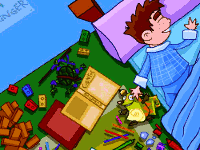How to tell bedtime stories
Tap the calamus image below to get free access to our best collection of stories for children with related activities. Download it to enjoy our stories whenever you want
Advertisement
![]() Where to start? Download our free Workbook of Values, watch our animated stories and enjoy Jakhu Stories, our stories for kids app
Where to start? Download our free Workbook of Values, watch our animated stories and enjoy Jakhu Stories, our stories for kids app

Bedtime stories have a lot going for them, as I detailed in the article "The valuable role of stories in education and family life". But one of the most important factors in making full use of stories - particularly bedtime stories - is knowing how to tell them. Stories can be so much more than just another part of a routine, or an entertaining few minutes. They can provide a magical and very educational experience. My method works wonderfully, and here's how I manage it: it isn't only my children who eagerly await their story every night. Their father looks forward to it too, and I enjoy every moment of it.
Bedtime stories are an important element of home life. Children wait for them with excited expectation because the story is something new and distinct every time. This sense of expectation provides the bedtime story's first benefit: it gets the kids into bed on time. Of course, it also gets them to finish their supper without delay. I'm very straight with my children on this point: if they want to dawdle before bedtime they are free to do so, but when they finally get into bed it means they'll have missed story-time. And, let's face it, at that time of night there aren't many better things to do than listen to the bedtime story...
As I've already explained elsewhere, telling a new story each day, and doing it with an expressive voice, without books or pictures, helps children to learn to pay attention to something apart from visual stimuli. These days, children are bombarded by so much visual stimuli that many of them have trouble concentrating on anything that doesn't enter the mind via the eyes. I try to make the most of that opportunity. The second advantage is that not needing visual support means I can tell the story with the lights out (in fact, that's a prerequisite before I'm willing to start). Telling your story in that kind of shadowy environment - with just the corridor light on - has various advantages:
- It helps the children to fix their attention on my voice, and to use their imagination to visualise what I'm telling them. To this end, I try to introduce colours into my stories - often my characters have their own particular colours - in a way which practically forces the child to visualise that colour. So, purple elephants, red cows and yellow kangaroos are quite common in my stories :-)
- A lack of visual stimuli also helps the children to relax. They are used to processing visual input, and when this is taken away their brains calm down, and they're more likely to fall asleep sooner.
- Also, having the light off during the story accustoms the child to this environment. It will help them to sleep without needing the light on. Children lying in the dark will fall asleep sooner; again, it's the lack of visual stimulation.
A useful tip is to always start the story with the act of turning off the light, maybe with some phrase like "Are we ready for the story?" It also lets the children know they've completed all the things they needed to do before bedtime begins, and that they've reached the stage where they're ready to lie down, listen to the story, and go to sleep.
One rule is that once the story has started they must not interrupt it by doing other things. They have to do all those things before the story begins. They also know that I may ask them if they've done all their tasks, and that if they have not, the story won't begin.
As I have explained on other occasions, we start out by choosing the characters and colours for the story. It's an interesting moment when this happens; they start to think and imagine for themselves. They put themselves into the situation of the story. They also create a special connection with "their" characters, identifying with them in many different situations, and helping the child to immerse itself completely in the story.
Up to now, this little bedtime ritual has only served to introduce the story in a way which emphasises its importance. But, from this point onwards, the most important factor is the person telling the story. Have we given the story an air of magic and mystery, have we infused it with expectation, have we created several very special minutes? We can't be telling stories in the same way we would read a letter from the bank. What's needed is to employ the most human, most sensitive, most theatrical aspects of your nature; putting aside whatever qualms or hesitation you may feel, and putting yourself at the service of the child's imagination. As we are telling the story in the dark, the tone and rhythm of the voice truly takes over. So if there's a sad child in your story, the child must really sound sad. A fierce lion should frighten, and a big group of happy friends should sound like a party (just to clarify: I don't advise people to tell bedtime stories that are too exciting and action-packed, because afterwards this can make it harder to get to sleep).
I always end my stories by slowing down the tempo, and with a happy positive phrase or sentence. This allows the children to see that everything finished well; that those characters who were badly behaved finally mended their ways, and the like. This calms the children, and leaves them in a rested mood, so they sleep better.
Finally, the last thing I do with them is pray. This is useful to avoid them asking a lot of complicated questions about the story. It also provides another element of routine. After the prayer I give them a kiss, say goodnight, and quietly leave the bedroom (it wasn't always like this; I can still remember times when it was very difficult to get them to go to sleep...) :-) For those who are not religious, I guess you could easily replace this part with something else equally definite and unchanging, which will similarly help with the transition between the novelty of the story and the routine of sleep.
Back to children stories
Discover Storytelling benefits
Learn How to create Stories
Search for Stories within our huge collection

















Comments
Your advice is so useful! I
Your advice is so useful!
I love your site, I think it provides a lot of value to children and parents. Thank you and keep it up!
Lourdes